Stayed: Rio: Morro Dos Cabritos / When: February (during Carnaval Season)
São Paulo: Aclimacao Duration: Rio: 4.5 days SP: 4.5 days
Good For: Group trips of any kind
I’m the friend you call to take an impromptu trip.
A dear friend of mine from Barcelona whom I hadn’t seen since leaving in 2018 called me to say she’s going to Brazil for a few months to visit family and wants to go to Rio for a week; she asked if I’d like to join her… Say less. She picked a week and I booked.
After which, she told me the week she chose just happen to be the Carnaval week. For me this was bittersweet – while I’ve always wanted to go to carnaval in Rio, the more I looked into things I saw they closed a lot down during this time and was nervous I wouldn’t be able to see/explore the city the way I wanted to… this ended up not being a problem since towards the end of week everything opened up! Because while we were there during carnaval and wanted to participate we really were trying to see Rio – and that we did.
The Stay

In Rio de Janeiro we stayed in the favela community Morro Dos Cabritos. A favela by definition is a “slum or shantytown located within the outskirts of the city” but is really an umbrella term for several types of working-class neighborhoods. So when people ask me about staying in a favela my response is it’s similar to staying in Washington Heights or Greenwich Village (NYC) or El Raval o Gotico (BCN). So don’t mistake me they can be dangerous, but so can many places people frequent; I can (and just began to) write a page full regarding poverty, how people and places end up the way they do, survival tactics and how fucked the system is – but hopefully y’all already know all of that.
I did look into favelas before going, watched videos of expats staying in them, and surveyed the community. Our host was a superhost with great reviews and not for nothing I’ve lived in El Raval (considered the most dangerous neighborhood in Barcelona) and in Bedstuy (#8 in most dangerous neighborhoods in NYC). What’s considered dangerous to the world – these neighborhoods – I see so much community and unity. I’m not saying you should stay in a favela, honestly I wouldn’t suggest it to most people, but if you’re a seasoned traveler, street smart, and know some of the local language you should be fine, just be smart.
It wasn’t our preference to stay in a favela there, but with last minute planning and booking places either where booking within minutes or cancelling. Specifically, the favela I stayed in was very safe and our apartment was located at the beginning of the community, within 4 minutes of the police station and 15 minutes walking from the Copacabana/beach area which is considered one of their “safest areas.” We walked almost everywhere and throughout the Favela. We got to know some residents, the baker, the drug dealer, the old men who gossip in the morning, and get rides through the town and favela through moto-taxis. It was great.






In São Paulo, we spent a lot of time in an area called “Bras”, which has a large immigrant population . We stayed in Aclimacao, in a very quiet section but was close to their chinatown and downtown. In both areas I felt safe and were relatively quiet. In Bras, I was able to go to their street market (which i miss terribly) and on a Monday got to go through their shopping center, which really reminded me of Jamaica Ave style shopping.
Safety Tips
This a section I NEVER have in my blogs with the overwhelming comments/concerns I’ve received I want to give some tips from how EYE tried staying safe. Lets ignore scaremongering
- Keep the things you decide to take around with you to a minimum and close to your person.
- Make sure your things are secure and non-visable.
- Do not leave your things unattended, i.e. on the beach go in turns to the water.
- Dont be Dora the Explorer alone in an isolated area.
- Learn some of the language. (They speak portuguese and thats it! No your spanish isn’t enough. Maybeee 10% of people I met spoke some english and that was more than those who spoke spanish.)
- I also made resin self-defense knuckles (easy to slide in a pocket and to wear while walking around
When leaving our flat we usually ONLY took our phones which stayed in plastic pouches that hung around our necks and in our shirts, and 1 money pouch that held our money which fit under our pants. On days we took a small bag because we needed more things, we wore the backpack towards our front. While I never used the resin knuckles I made thankfully it did make me feel more secure, so some sort of comforting self-defense mechanism. While living in Barcelona and Brooklyn I had pepper spray.
Day/Nightlife
Rio – Since we went during Carnaval the scene was 24 hours a day. There are Blocas that start at any time maybe 5pm and end sometimes around 5am, and the big show Sambadrome. Then obviously most bars are busy and full of life. From 10am-till the beaches are full of people having different parties throughout. We dropped the ball in getting Sambadrome tickets, a person I met ended up getting $20 tickets the night of.. so it’s doable.. just be on it.
One of the best experiences I had was going to Blocos. Blocos are street parties organized by the neighborhood. These parties range from hundreds of attendees to 2 million. The first one I went to was in Lapa, a neighborhood with sooo much culture and some tourist sites but also has a reputation for being thee most dangerous neighborhood – so deciding to go to a street party there was.. well.. a risk. But a risk well taken, the energy of the crowd, the music, dancing, drinks, pizza was incredible. Before the Bloca we spent most of our time at this bar named Choperia do Papai
During the day we went to a Bloca that spanned the whole Ipanema beach, then that moved to the boardwalk/street area and later within the community. It ended with their band performing at the park which was amazing to see.
São Paulo – on the last Saturday of Carnaval, we enjoyed the Jardim das Bandeiras/ Vila Madalena district. This area is spectacular. They have fun restaurants, tons of bars, all with live music, and artwork of all forms. This area reminds me Placa Riel and the close area around it in Gotico (in BCN), or South Street and Fishtown area (in Philly). They blocked off the streets so people could party in them, it was a grand time. We also found a few Blocos within this area as well. Within this area, they also are infamous for “Batman’s Alley”. It’s a long stretch of road showcasing some of the most impressive spray paint murals around.
On a weekday we went to an area Itaim Bibi/Pinheiros which are the business districts. Besides that they are known for their restaurants and bars. It’s a cool/hip area definitely for an older young adult crowd with really nice options. I saw people on dates, birthday dinners, and friend gatherings.
The Food



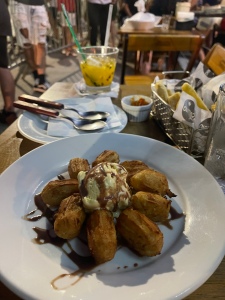
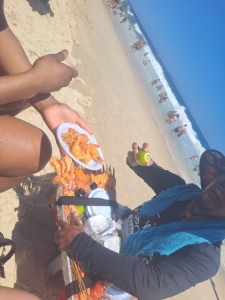






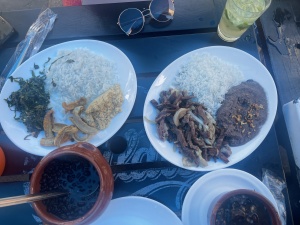
Lots of food… lots and lots of food. Here are some typical Brazilian dishes I had:
- Feijoada – black beans slowly cooked in a pot with chunks of pork (or other meat cuts). Served with rice.
- Pao de Queijo – cheese bread! or what some call cheese puffs. DELICIOUS.. this is the little cheese bread balls you’ve definitely had at Fogo de Chaos or other steakhouses
- Churrasco de Picanha – Brazilian barbecue! or what we know as Brazilian steakhouses. i.e. Fogo de Chao, Chima, Picanha, etc. It’s the eat till you burst amazingness of some fine cuts of meat grilled in its own fat.
- Cachorro Quente – literally hot dogs. I was on a mission to try one of these street dogs but with everyyyythingggg else I could not fit it in. but they’re very popular.
- Farofa – a mix of flour, butter, garlic, and onions fried until toasted. Its typically a side dish or added ontop of meats. In my experience the more golden it is, the better. lighskin farofa aint it.
- Mandoica Frita -fried manioc which is similar to yuca. So think Yuca fries
- Espetinho de Coracao – chicken hearts… and actually they taste great.
- Carne de sol – a piece of beef that is heavily salted and left to cure for a couple of days until dried out with lots of onions.
On top of all this amazingness I got to eat – I also got to eat some traditional Lebanese food from my friends family, dont ask me the names I just know they were great, meaty, fresh and bright. I also had some typical dishes made the Brazilian way – like a hamburger and pizza. (definitely have the pizza! you can skip the burger)
Excursions
Historic Walking Tour – On my first day in Rio I wanted to get touring out of the way. Most tours were canceling due to carnaval but luckily I was still able to get one in… In the end I hated the tour lol, It wasn’t too engaging and a lot of things were closed… but I chalk this up to it being carnaval season so hey.
We took a Full-day Boat Tour that left from Angra dos Reis (about 2hrs from Rio) and cruised through the paradisiacal islands of the bay of Angra dos Reis (Lagoa Azul, Freguesia de santana, Cataguases)and Ihla Grande/Japariz the largest and best-known island in the region. This tour was amazing! the boat had a slide that you could use to get into the water, otherwise just jump off! They provided life-vest and floaties if needed. We got to swim with fishes, snorkel if you wanted to, etc. The water was super salty but it was beautiful and nice. The main town of Angra dos Reis was also very pretty and quaint, reminding me a but of San Sebastian in Spain, I would of liked to spend more time in that town. They offered a lunch buffet set at a restaurant on the water. No exaggeration this takes all day 7am meet – 10pm drop off. But its surely a great time and if you’re a lover of the sea its great. We booked it through a Brazilian company direct, but you can find these tours by the dozen on Viator or Trip Advisor so take your pick!




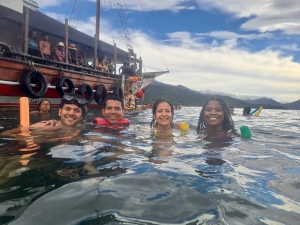


We saw the big Man, Christ the Redeemer ! This was probably the tourist site I wanted to visit the most. I meannnn it is part of the Seven Wonders of the Modern World! IT DID NOT DISAPPOINT. the statue was beautiful and lively. I probably could of sat up there staring at it and out onto Rio. The wait wasn’t long at all , there will be people right before the lift entrance offering to drive you up for a fee to skip the line and get up faster – sounds cool but the train is sooo much cooler, and roundtrip is cheaper than the van and not a bad wait. For this we didn’t purchase tickets online we got them on site. There was little to no wait.
Sugarloaf Mountain was… exhausting. To be fair we went at the end of a longgggggg day of touring the city by foot and without eating. Is Sugarloaf beautiful? absolutely… do I need to go again? never.

So the wait is horrendous, and you essentially have to wait 4 different times so be ready to stand and wait. You’ll fast track the first line if you order your tickets ahead of time online. The first cable car takes you to Morro da Urca which stands at 220 meters, then a second cable car takes you to Guanabara Bay which stands 369 meters high and is home to Sugarloaf.
Most people suggest going at nightfall or to see the sunset, while it was pretty to see, so quickly you couldnt see much at all due to the darkness, overcast, and fog. I feel like early evening would be just as nice without the rush (maybe).



Then I planned a tour myself! From research I did prior to going there were a few spots I wanted to make sure we hit. As a precursor, I became fascinated with the Afro-Brazilian culture. How it formed, it’s roots, its similarities and differences to Afro-American history and I learnt sooo much going down this rabbit hole. Many stops on the tour I created are beautiful but have a really dark past or connotation that I’ll be discussing. This “one hour 15minute by foot” tour (not including the time we took to stop and and enjoy our surroundings), consisted of:

Escadaria Selarón/ Selaron Steps : A chilean-born artist gifted these 215 steps, all covered in ceramic tiles from all around the world, as “my tribute to the Brazilian people”. Best time to go? The earlier the better, but regardless of time it will be busy, there will be people lined up to take a photo etc., BUT my assumption is the earlier you go the less chaotic it is or filled up… it’s like asking when’s the best time to visit Time Square? never lol.. but less people will probably be around early early morning.
Rio de Janeiro Cathedral : The catholic cathedral was intended to echo ancient Mayan Pyramids, and that it does. It’s beautiful and apparently the home church to majority of Rio residents. There’s also a museum in the basement of the church with a lot of old history, if you go make sure to ask about that little gem.
Largo de São Francisco da Prainha : Home to the Mercedes Baptista statue (the first black woman

to dance at the Teatro Municipal in Rio), She was responsible for linking the world of Afro-Brazilian dance with classical dance. She toured the world, and started her own Samba school.
Unfortunately this square is also infamous for their underground slave trade or in actuality human trafficking. The square hosted a slave market where they kept African captives under the control of slave traders and typically underneath the shops in the square. On some of ithe buildings you’ll still see chains where they held captives and administered the death penalty. The area feels heavy. It was weird seeing so many people just sitting around eating and joyous while I could only think about the history and pain.
Candeleria Church : When I first looked up information about this church I got a lot of cool facts. A couple who got shipwrecked in 1610 survived, and made an oath to create a chapel naming it after their ship. – blah blah blah – this is honestly one of the most beautiful cathedrals I’ve ever seen.
But right outside of this church you will see 8 red bodies painted on the ground to signify the 8 young poor black boys who were killed right on the churches steps by off-duty cops trying to “clean up the city”. When i looked up the church I found nothing about this… until I put “black history” then BOOM “1993 – the Candelaria Massacre” came up. It’s a story that made me cry, the first time but not the last time I cried reading their history.
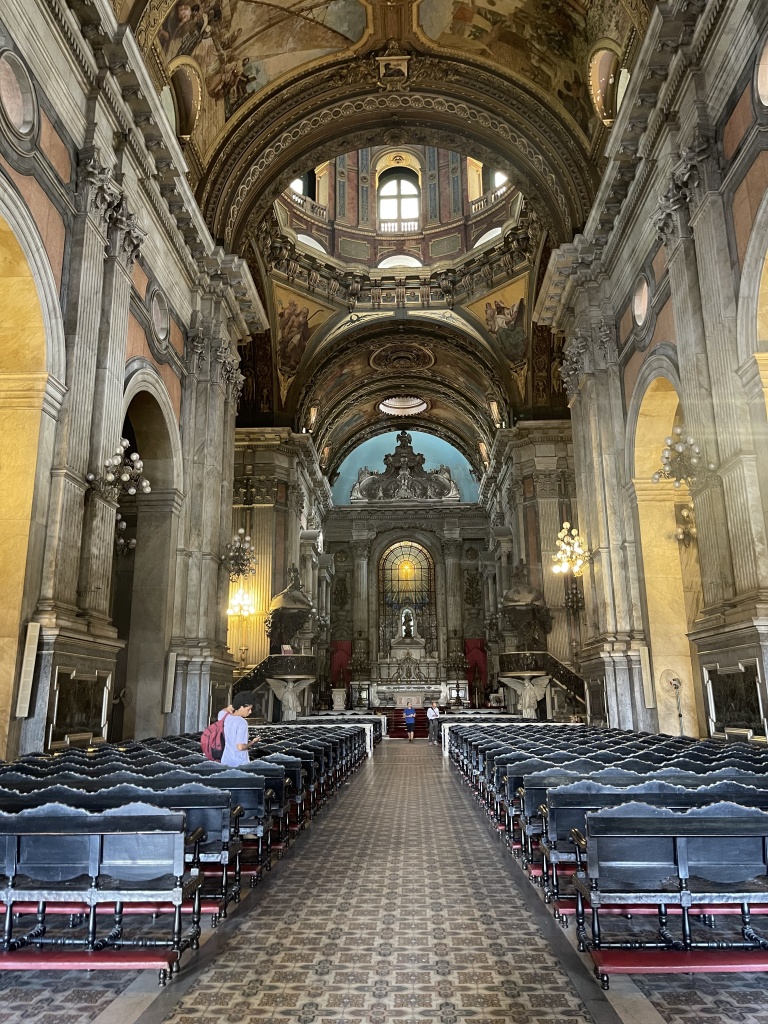
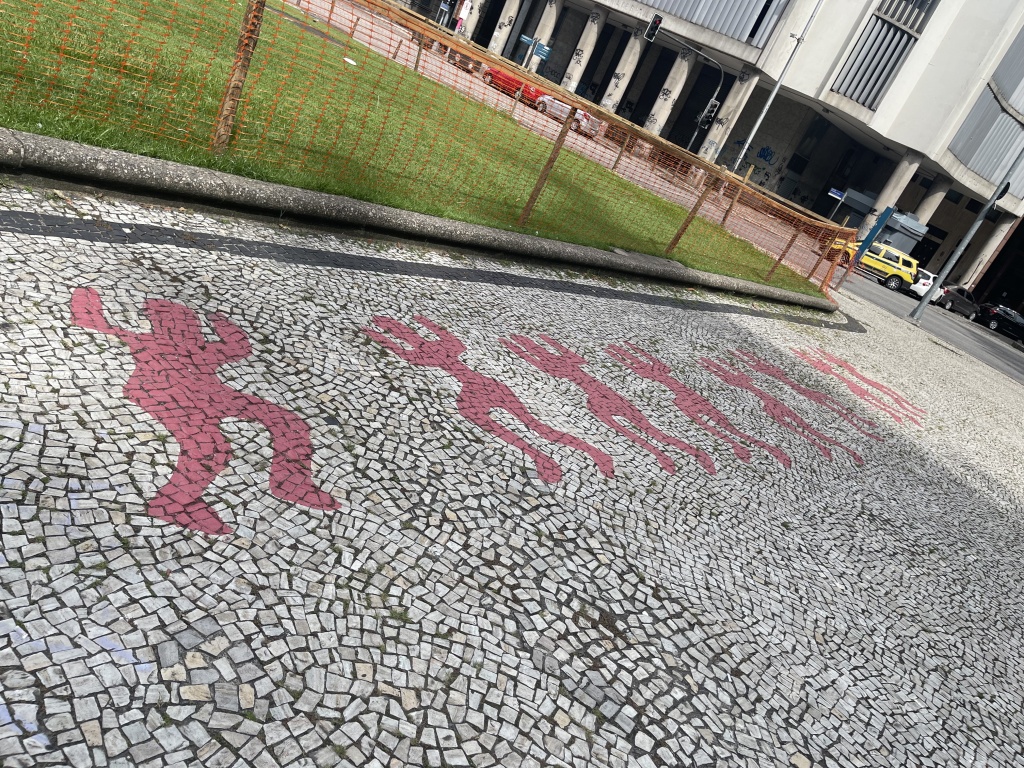


Museu do Amanhã : is one of the most beautiful and most forward thinking museum I’ve ever been in. As a public health professional I see this museum as a beautiful tool, one that should be duplicated and explored everywhere. The Museum of Tomorrow is an applied Sciences museum which explores the opportunities and challenges which humanity will be forced to tackle in the coming decades from the perspective of sustainability and conviviality.
It’s also in the exact location of what was once the slave port, the essential epicenter of the slave trade. While within the Museum they make it a point to discuss humanity and efforts that should be taken in the future; they fail to discuss or mention the community in which they pushed out to create such a site.
Pedro do Sal/Salt Stone :

Pedro do Sal, was the the 2nd place I felt most connected to my African roots
What is know as “the cradle of samba”, where the first songs were played and composed, is also the host of a longer history that explained how that came to be.
Most enslaved people have climbed these steps, especially and specifically depending on what their “work” was. After slavery in it’s typical fashion had ended, a new thing rose called “earning slaves” which is similar to Americas indentured slaves. These people were able to earn a wage which could have been in the form of shelter and food, or small amounts of money. Anyone could buy/hire these “earning slaves” including other poor brazilians. (theres a long history I’d LOVE to dive into… but for all intensive purposed I wont… use your googles)
In any case, these earning slaved became part of a community, most living in this area uptop of the steps and formed networks. They created “freedom pools” similar to money pools now, where they would fund money to buy each others freedom. In this neighborhood higher up, white men wouldn’t enter and it was considered essentially lawless. They formed a government modelled after the Empire, and would vote for their Kings, Queens, and court. Women being the most skilled (due to their house work etc.) and usually first to win their freedom, ran this neighborhood being the anchor of Afro-brazilian social life; Eventually forming Samba Schools. They had houses, food, and men would gather to eat, drink, talk, sing, drum, form freedom pools, etc. THIS was their community – still their community.
If you happen to be their on a Monday go over to the steps around 9pm for their weekly samba parties which draws thousands. Also be careful.
Valongo complex/ Cemetery of the New Blacks :
The “Valongo” is not a specific spot in the city, but a region. There’s a lot to say about this area but not a lot that remains. When I got to the Port Maravilha there was nothing more than a small plaque. They did little to preserve the past and history and it wasn’t until the 2016 Olymmpics where workers began digging up the road for drainage and outrage ensued between members of the local Gamboa area, Black Movement orgs., and officials. Read more here.
Eticas Mural : For 2016s Rio Olympics, artist Eduardo Kobra created a 30,000 square foot, 50 feet tall wall mural. It features five faces from five different continents that represent both the five Olympic rings as well as the cultural diversity. “These are the indigenous people of the world,… I wanted to show that everyone is united” – Kobra





There’s so much to write about, and I’m sure I’ve forgotten things. All in all Brazil is amazing, it has a long complicated history, the people of the country are beautiful and I WILL be going back.
Obrigado por tudo!














